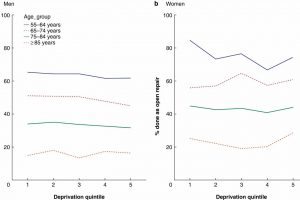Study finds socioeconomic disparities in operation and survival rates for abdominal aortic aneurysm


A new study from the University of Sheffield has found clear evidence of socioeconomic disparities in operation rates and survival after surgery for dangerous abdominal aortic aneurysms.
The study, published in the British Journal of Surgery, found that amongst admitted patients, men from more deprived areas were more likely to die in hospital without having their aneurysm repaired than men from less deprived areas.
Among men who had aneurysm surgery, this was more likely to be for a ruptured aneurysm in men from more deprived compared with less deprived areas.
In men who had had a repair for an aneurysm that had not ruptured, those from more deprived areas were more likely to have this carried out as an emergency procedure than men from less deprived areas.
Additionally, the research highlighted that the death rate following surgery was higher in men from more deprived areas, although the magnitude of the increased risk diminished with increasing age.
In women, the association between socioeconomic deprivation and survival following surgery was less clear.
The aorta is the main blood vessel that carries blood from the heart through the chest and abdomen. An aneurysm is a bulge in a blood vessel. In the aorta, this typically occurs in the abdomen. If the aneurysm ruptures (bursts), life-threatening bleeding occurs with a serious risk of death. Larger aneurysms are more likely to rupture and surgery can be carried out to repair the aneurysm. Surgery is much better done as a planned procedure rather than as an emergency.
Abdominal aortic aneurysm is more common in men and in older age, and it is more common in people living in socioeconomically deprived areas.
The Sheffield study was conducted by researchers from the University’s School of Health and Related Research (ScHARR). Additionally, it found that planned surgery rates (calculated as a rate for the population) were higher in middle-aged men living in deprived areas, as expected. However, planned surgery rates were lower in older men in more deprived areas. Instead, there were higher emergency surgery rates, including surgery for ruptured aneurysm, in more deprived areas.
Professor Ravi Maheswaran, Professor of Epidemiology and Public Health at the University of Sheffield’s School of Health and Related Research led the Sheffield study. He says, “The disparities that we have found are clearly unacceptable. There is a national NHS screening program which offers screening for abdominal aortic aneurysm to all men when they turn 65 but uptake is lower in more deprived areas. We know that this could lead to men living in deprived areas having later diagnosis, greater risk of emergency surgery and poorer outcomes, including death.”
Professor Jonathan Michaels, Honorary Professor of Clinical Decision Science at the University of Sheffield’s School of Health and Related Research, was co-investigator on the study. He has previously worked as an NHS Consultant Vascular Surgeon in Sheffield, and adds, “Interventions that can increase the uptake of aneurysm screening in socioeconomically deprived areas should lead to finding and surgically treating more men with aneurysms in these areas.
“Earlier identification of men with aneurysms should also help men who would benefit from lifestyle changes. This could include stopping smoking, eating healthily, exercising regularly and maintaining a healthy weight which will help to reduce operative risks and cardiovascular mortality.”
More information:
Ravi Maheswaran et al, Socioeconomic disparities in abdominal aortic aneurysm repair rates and survival, British Journal of Surgery (2022). DOI: 10.1093/bjs/znac222
Journal information:
British Journal of Surgery
Source: Read Full Article